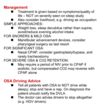Chronic - Obstructive sleep apnoea Flashcards
Name 3 risk factors for OSA.
obesity
macroglossia: acromegaly, hypothyroidism, amyloidosis
large tonsils
Marfan’s syndrome
How does OSA present?
Daytime somnolence due to waking up from sleep
Partner complaining of snoring or apnoea attacks
Hypertension (with every arousal there is a rise in BP)
Nocturia
Reduced libido
What would be the acid base status of someone with OSA?
Compensated respiratory acidosis
How can you assess sleepiness in OSA?
Epworth Sleepiness Scale - questionnaire completed by patient +/- partner
Multiple Sleep Latency Test (MSLT) - measures the time to fall asleep in a dark room (using EEG criteria)
What is the diagnostic test for OSA?
sleep studies (polysomnography) - ranging from monitoring of pulse oximetry at night to full polysomnography where a wide variety of physiological factors are measured including EEG, respiratory airflow, thoraco-abdominal movement, snoring and pulse oximetry
How is OSA managed?
- weight loss
- continuous positive airway pressure (CPAP) is first line for moderate or severe OSAHS
- intra-oral devices (e.g. mandibular advancement) may be used if CPAP is not tolerated or for patients with mild OSAHS where there is no daytime sleepiness
- the DVLA should be informed if OSAHS is causing excessive daytime sleepiness
- limited evidence to support use of pharmacological agents



